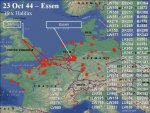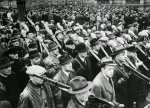After some of the pix, I got curious and read a bit about tank-killers and their development, particularly why you just don't see them any more. I came away realizing that, limited though they were, they were absolutely dictated in Normandy on by the superiority of the German tanks' firepower. And they were cheap and easy to build...
75th anniversary of D-Day...
- Thread starter crimsonaudio
- Start date
- Status
- Not open for further replies.
October 19, 1944: Feldmarschal Model calls off the attempts to relieve Aachen as American attacks continue to overwhelm the cities defenses. The US forces have cleared much of the city, continuing to go door to door and pushing the Germans to the center of the city, where they join the forces holed up at the Quellenhof. Further south, forces of the US 7th Army capture Bruyeres. Nearby, other units prepare to assault St. Die.
In Italy, the battle at the Gothic Line continues as troops of the British 10th Indian Division, (part of British 5th Corps (an element of British 8th Army)) attack across the Savio River. The British 8th Army pushes into Civitella di Romagna and Cesena, while the US 5th Army attacks around Monte Salvaro, Monte Grande, Monte Cerere, Monte Fano, Monte Belmonte, Monte Spadura, Monte dell'Acqua Saluta, Monte Pianoreno, Monte Casalino, and Monte Ceco.
Allied bombing raids are stepped up after a few days of bad weather - US 8th Air Force attacks Mannheim (and targets of opportunity) with 358 bombers, attacks Gustavsburg with 50 bombers, and attacks Mainz with 280 bombers. RAF Bomber Command sends 583 aircraft to attack Stuttgart overnight, 263 aircraft to attack Nuremberg overnight, and 48 aircraft to attack Wiesbaden overnight.
Hitler orders the complete and total destruction of the city of Warsaw, Poland, and the German 4.Armee withdraws from around Tilsit, East Prussia, Germany.
Pictured: A Sherman tank makes its way through the main entrance of the train station of Aachen; German civilians leaving Aachen on 19 October 1944; 2LT Robert H. Meek was KIA October 19, 1944 over the Magenta Bridge near Milan while flying as co-pilot of 7Z "Shirley Ann”. He was buried in the Sicily Rome American Cemetery Nettuno Italy.
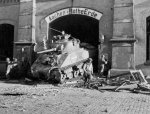
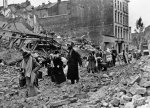
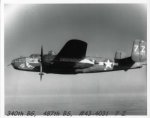
In Italy, the battle at the Gothic Line continues as troops of the British 10th Indian Division, (part of British 5th Corps (an element of British 8th Army)) attack across the Savio River. The British 8th Army pushes into Civitella di Romagna and Cesena, while the US 5th Army attacks around Monte Salvaro, Monte Grande, Monte Cerere, Monte Fano, Monte Belmonte, Monte Spadura, Monte dell'Acqua Saluta, Monte Pianoreno, Monte Casalino, and Monte Ceco.
Allied bombing raids are stepped up after a few days of bad weather - US 8th Air Force attacks Mannheim (and targets of opportunity) with 358 bombers, attacks Gustavsburg with 50 bombers, and attacks Mainz with 280 bombers. RAF Bomber Command sends 583 aircraft to attack Stuttgart overnight, 263 aircraft to attack Nuremberg overnight, and 48 aircraft to attack Wiesbaden overnight.
Hitler orders the complete and total destruction of the city of Warsaw, Poland, and the German 4.Armee withdraws from around Tilsit, East Prussia, Germany.
Pictured: A Sherman tank makes its way through the main entrance of the train station of Aachen; German civilians leaving Aachen on 19 October 1944; 2LT Robert H. Meek was KIA October 19, 1944 over the Magenta Bridge near Milan while flying as co-pilot of 7Z "Shirley Ann”. He was buried in the Sicily Rome American Cemetery Nettuno Italy.



October 20, 1944: As the Battle of Aachen - the first German city attacked by Allied forces - appears to be coming to an end, Colonel Wilck (http://en.wikipedia.org/wiki/Gerhard_Wilck) issues an order:
______
“The defenders of Aachen will prepare for their last battle. Constricted to the smallest possible space, we shall fight to the last man, the last shell, the last bullet, in accordance with the Fuehrer’s orders. In the face of the contemptible, despicable treason committed by certain individuals, I expect each and every defender of the venerable Imperial City of Aachen to do his duty to the end, in fulfillment of our Oath to the Flag. I expect courage and determination to hold out. Long live the Fuehrer and our beloved Fatherland!”
______
This rallying cray actually does little as the resistance crumbles rapidly in the face of the determined American forces. Even though the battalion of the 110th Infantry is officially committed only as a defensive role, the unit joins Lt. Col. Derrill M. Daniel’s battalion in eviscerating the city. Colonel Daniel’s men already seized the main railroad station and are nearing a railway line leading north to Laurensberg and Geilenkirchen, separating the main part of Aachen from western residential sectors. After the collapse of a strongpoint in the Technical University in the northwestern corner of the city, the battalion reaches the western railroad tracks as night falls. The few Germans remaining are corralled in the western and southwestern suburbs.
Operation Suitcase begins, as Canadian 4th Armored Division advances to take Esschen, 7 miles east of Bergen-op-Zoom on the Dutch-Belgium border (this marks the only time an American division serves under Canadian command during the war). The British 1st Corps (part of Canadian 1st Army) begins attacking northward from northeast of Antwerp. The Canadian 1st Army attacks Breskens pocket and pushing toward Woensdrecht, the US 1st Army attacks around Bardenberg, Mariadorf, and Schmidt, US 3rd Army attacks Maizieres-les-Metz but loses Fossieux to German counterattack. US 19th Tactical Air Force breaches the dam at Dieuze, causing extensive flooding to the rear of German 1st Army, opposite US 3rd Army. The US 7th Army clears Foret de Parroy with German forces withdrawing overnight and the French 1st Army, attacks around Le Thillot, capturing Trougemount.
Allied bombing raids continue over Germany as the US 8th Air Force attacks Schweinfurt with 329 bombers, Koblenz with 360 bombers, Mainz with 210 bombers, and Gustavsburg with 148 bombers. RAF Bomber Command sends 435 aircraft to attack Bochum, 47 aircraft to attack Wilhelmshaven, and12 aircraft to attack Krefeld, Saarbrucken, and Dusseldorf overnight
In Italy, elements of the British 8th Army push north along Highway 71 while the South African 6th Armored Division (an element of US 5th Army) repulses a German counterattack. To the east, the British 4th and 46th Divisions of British 5th Corps (part of British 8th Army) enter Cesena. US 88th Division captures Monte Grande, Italy while US 5th Army attacks around Monte Cauala, Barga, Monterumici, Livergnano, La Villa, and Gesso.
Pictured: The destroyed infrastructure of Aachen; Civilians are forced to surrender arms and cameras in Aachen; Mission photo from the 461st Bombardment Group’s attack on Isotta Fraschini Works in Milan, Italy

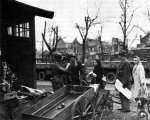
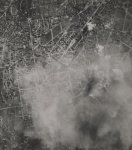
______
“The defenders of Aachen will prepare for their last battle. Constricted to the smallest possible space, we shall fight to the last man, the last shell, the last bullet, in accordance with the Fuehrer’s orders. In the face of the contemptible, despicable treason committed by certain individuals, I expect each and every defender of the venerable Imperial City of Aachen to do his duty to the end, in fulfillment of our Oath to the Flag. I expect courage and determination to hold out. Long live the Fuehrer and our beloved Fatherland!”
______
This rallying cray actually does little as the resistance crumbles rapidly in the face of the determined American forces. Even though the battalion of the 110th Infantry is officially committed only as a defensive role, the unit joins Lt. Col. Derrill M. Daniel’s battalion in eviscerating the city. Colonel Daniel’s men already seized the main railroad station and are nearing a railway line leading north to Laurensberg and Geilenkirchen, separating the main part of Aachen from western residential sectors. After the collapse of a strongpoint in the Technical University in the northwestern corner of the city, the battalion reaches the western railroad tracks as night falls. The few Germans remaining are corralled in the western and southwestern suburbs.
Operation Suitcase begins, as Canadian 4th Armored Division advances to take Esschen, 7 miles east of Bergen-op-Zoom on the Dutch-Belgium border (this marks the only time an American division serves under Canadian command during the war). The British 1st Corps (part of Canadian 1st Army) begins attacking northward from northeast of Antwerp. The Canadian 1st Army attacks Breskens pocket and pushing toward Woensdrecht, the US 1st Army attacks around Bardenberg, Mariadorf, and Schmidt, US 3rd Army attacks Maizieres-les-Metz but loses Fossieux to German counterattack. US 19th Tactical Air Force breaches the dam at Dieuze, causing extensive flooding to the rear of German 1st Army, opposite US 3rd Army. The US 7th Army clears Foret de Parroy with German forces withdrawing overnight and the French 1st Army, attacks around Le Thillot, capturing Trougemount.
Allied bombing raids continue over Germany as the US 8th Air Force attacks Schweinfurt with 329 bombers, Koblenz with 360 bombers, Mainz with 210 bombers, and Gustavsburg with 148 bombers. RAF Bomber Command sends 435 aircraft to attack Bochum, 47 aircraft to attack Wilhelmshaven, and12 aircraft to attack Krefeld, Saarbrucken, and Dusseldorf overnight
In Italy, elements of the British 8th Army push north along Highway 71 while the South African 6th Armored Division (an element of US 5th Army) repulses a German counterattack. To the east, the British 4th and 46th Divisions of British 5th Corps (part of British 8th Army) enter Cesena. US 88th Division captures Monte Grande, Italy while US 5th Army attacks around Monte Cauala, Barga, Monterumici, Livergnano, La Villa, and Gesso.
Pictured: The destroyed infrastructure of Aachen; Civilians are forced to surrender arms and cameras in Aachen; Mission photo from the 461st Bombardment Group’s attack on Isotta Fraschini Works in Milan, Italy



The 104th Infantry Division (the Timberwolves) I had to look it up. The 104th ID's unit patch.October 20, 1944: ...
Operation Suitcase begins, as Canadian 4th Armored Division advances to take Esschen, 7 miles east of Bergen-op-Zoom on the Dutch-Belgium border (this marks the only time an American division serves under Canadian command during the war).

Still around in the US Army Reserve.
October 21, 1944: Soldiers of the 26th Infantry Regiment, supported by the reinforced battalion of the 110th Infantry Regiment finally conquer central Aachen, marking the surrender of the last German garrison (in the Hotel Quellenhof) and ending the battle for the city. Aachen becomes the first city on German soil to fall to the Allies.
The Battle of Aachen was costly to both the Americans and Germans: the US suffered over 5,000 casualties, while the Germans had over 5,000 casualties and 5,600 taken prisoner. Since October 2, the 30th Infantry Division have suffered roughly 3,000 men killed and wounded, while the 1st Infantry Division lost at least 1,350 casualties (150 killed and 1,200 wounded). The Germans lost another 5,100 casualties during the fighting in Aachen itself, including 3,473 prisoners. During the battle, the Wehrmacht lost two complete divisions while another eight have been severely depleted, including three fresh infantry divisions and a single refitted armored division. These losses are largely attributed to how they fought, as although an equivalent of 20 infantry battalions were used during various counterattacks against the 30th Infantry Division alone, on average each separate attack only involved two infantry regiments. During the conflict, the Germans have also developed a respect for the fighting ability of American forces, noting their capability to fire indiscriminately with overwhelming amounts of artillery fire support and armored forces. Both the 30th Infantry and 1st Infantry divisions receive distinguished unit citations for their actions at Aachen.
Canadian troops captured Breskens, the Netherlands. Four German Panther tanks and two self-propelled guns strike at Canadian Seaforths, but are ambushed by Canadian tank-hunting team.
Once again, Allied air superiority allows the bombing of crucial German infrastructure - US 8th Air Force attacks Schweinfurt with 329 bombers, Koblenz with 360 bombers, Mainz with 210 bombers, and Gustavsburg with 148 bombers. RAF Bomber Command sends 435 aircraft to attack Bochum, 47 aircraft to attack Wilhelmshaven, and sends 12 aircraft to attack Krefeld, Saarbrucken, and Dusseldorf - all in overnight raids.
In Italy, British 5th Corps and Canadian 1st Corps continue to cross the Savio River.
German Jews who were previously protected by their Aryan spouses were now deported from Germany. The German RSHA (http://en.wikipedia.org/wiki/SS-Reichssicherheitshauptamt) office ordered that the Gestapo execute foreign laborers.
Pictured: German prisoners of war march through the destruction after the fall of Aachen; German prisoners of war carrying wounded members of the 1st Canadian Corps through Cesena. October 21, 1944; Situation map from October 21, 1944
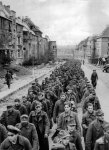
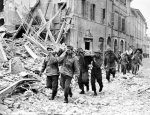
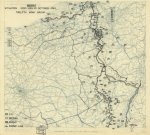
The Battle of Aachen was costly to both the Americans and Germans: the US suffered over 5,000 casualties, while the Germans had over 5,000 casualties and 5,600 taken prisoner. Since October 2, the 30th Infantry Division have suffered roughly 3,000 men killed and wounded, while the 1st Infantry Division lost at least 1,350 casualties (150 killed and 1,200 wounded). The Germans lost another 5,100 casualties during the fighting in Aachen itself, including 3,473 prisoners. During the battle, the Wehrmacht lost two complete divisions while another eight have been severely depleted, including three fresh infantry divisions and a single refitted armored division. These losses are largely attributed to how they fought, as although an equivalent of 20 infantry battalions were used during various counterattacks against the 30th Infantry Division alone, on average each separate attack only involved two infantry regiments. During the conflict, the Germans have also developed a respect for the fighting ability of American forces, noting their capability to fire indiscriminately with overwhelming amounts of artillery fire support and armored forces. Both the 30th Infantry and 1st Infantry divisions receive distinguished unit citations for their actions at Aachen.
Canadian troops captured Breskens, the Netherlands. Four German Panther tanks and two self-propelled guns strike at Canadian Seaforths, but are ambushed by Canadian tank-hunting team.
Once again, Allied air superiority allows the bombing of crucial German infrastructure - US 8th Air Force attacks Schweinfurt with 329 bombers, Koblenz with 360 bombers, Mainz with 210 bombers, and Gustavsburg with 148 bombers. RAF Bomber Command sends 435 aircraft to attack Bochum, 47 aircraft to attack Wilhelmshaven, and sends 12 aircraft to attack Krefeld, Saarbrucken, and Dusseldorf - all in overnight raids.
In Italy, British 5th Corps and Canadian 1st Corps continue to cross the Savio River.
German Jews who were previously protected by their Aryan spouses were now deported from Germany. The German RSHA (http://en.wikipedia.org/wiki/SS-Reichssicherheitshauptamt) office ordered that the Gestapo execute foreign laborers.
Pictured: German prisoners of war march through the destruction after the fall of Aachen; German prisoners of war carrying wounded members of the 1st Canadian Corps through Cesena. October 21, 1944; Situation map from October 21, 1944



Two things I notice about that:
1. The clustering of German (and American) forces around Aachen (There are thirteen German divisions in and around Aachen) and Nancy/Luneville, France (six German divisions and two panzer brigades).
2. How devoid of troops the Ardennes were. The US 8th ID and the German 2nd SS Panzer Division were about it. 75 km of frontage and one division on either side of the line.
The troops are not distributed evenly across the battlefield.
There is another thing, the steady decline of the tactical abilities of the Wehrmacht. As 1944 found on, the seasoned troops were replaced by greener and greener troops, who made a lot of rookie mistakes. The results were that the Allies (and Soviets, for that matter) had an easier and easier time inflicting catastrophic losses on the Germans.October 21, 1944: ... The Battle of Aachen was costly to both the Americans and Germans: the US suffered over 5,000 casualties, while the Germans had over 5,000 casualties and 5,600 taken prisoner. Since October 2, the 30th Infantry Division have suffered roughly 3,000 men killed and wounded, while the 1st Infantry Division lost at least 1,350 casualties (150 killed and 1,200 wounded). The Germans lost another 5,100 casualties during the fighting in Aachen itself, including 3,473 prisoners. During the battle, the Wehrmacht lost two complete divisions while another eight have been severely depleted, including three fresh infantry divisions and a single refitted armored division. These losses are largely attributed to how they fought, as although an equivalent of 20 infantry battalions were used during various counterattacks against the 30th Infantry Division alone, on average each separate attack only involved two infantry regiments.
Throw on top of that, total air superiority.There is another thing, the steady decline of the tactical abilities of the Wehrmacht. As 1944 found on, the seasoned troops were replaced by greener and greener troops, who made a lot of rookie mistakes. The results were that the Allies (and Soviets, for that matter) had an easier and easier time inflicting catastrophic losses on the Germans.
There is another thing, the steady decline of the tactical abilities of the Wehrmacht. As 1944 found on, the seasoned troops were replaced by greener and greener troops, who made a lot of rookie mistakes. The results were that the Allies (and Soviets, for that matter) had an easier and easier time inflicting catastrophic losses on the Germans.
A pretty good snapshot of the general debacle...[/SUP][/SIZE]This fight, characterized warmly by the XV Corps commander as a "brilliant" example of perfect air-ground co-ordination, not only was an outstanding feat of arms but also had dealt a crippling blow to Hitler's plans for an armored thrust into the Third Army flank. The 112th Panzer Brigude had lost nearly all of its Panther battalion--only four of these heavy tanks escaped the Dompaire debacle. In addition the Mark IV battalion had sustained some loss, bringing the total number of tanks destroyed to sixty[SIZE=-1][SUP].
Dompaire was a great example of a rookie mistake. Placing an armored battalion inside a town without posting security in the hills around the town left the unit exposed and vulnerable. Even sending a squad of infantry to the hilltops around town would have alerted the brigade commander that he was surrounded. Camouflaging the tanks would have helped reduce losses to Allied air support.A pretty good snapshot of the general debacle...[/SUP][/SIZE]
One of the French commanders at Dompaire was Jacques Massu, later of Algeria Putsch fame (infamy?).A pretty good snapshot of the general debacle...[/SUP][/SIZE]
In Algeria in 1958, de Gaulle met Massu and this exchange happened.
De Gaulle: “Alors, Massu, toujours con?” (“So, Massu, are you still stupid?”)
Massu: “Oui, mon générale. Toujours Gaullist.” (“Yes, sir! I’m still a Gaullist.”)
October 22, 1944: Following the fall of Aachen, the headquarters of US 9th Army moves to the northern flank of US 1st Army, taking command of units in that sector, while the headquarters of US 1st Army takes command of units formerly under 9th Army and shifts its boundary south. Meanwhile, the US 3rd Army regroups while making limited attacks to adjust frontage. US 7th Army completes mopping up around Brouvelieures and captures high ground east of Foret de Parroy, then pushes toward St Die. Elements of Canadian 1st Army complete the capture of Breskens on the south bank of the Scheldt estuary. In southern Holland, the British 12th Corps (part of British 2nd Army) attacks toward Tilburg and Hertogenbosch. Canadian I Corps establishes a bridgehead over the Savio River. During this, Private Ernest Smith single-handedly destroys a German counterattack using an anti-tank gun and a machine-gun, and carries his wounded partner back for medical attention - he is later awarded the Victoria Cross for his efforts.
The German 444 and 485 Mobile Artillery Detachments, responsible for launching V-2 rockets, arrive at the Hague, the Netherlands. The units immediately begin to set up their equipment for a renewed rocket campaign against London.
In a one-on-one conversation between Adolf Hitler and Otto Skorzeny, Skorzeny tells of the kidnapping of Miklós Horthy, Jr. and the attack on Castle Hill in Budapest, Hungary on October 15. Later in the conversation, Hitler reveals to Skorzeny the plans for the Ardennes Offensive and asks him to plan a commando operation behind enemy lines in captured uniforms. When Skorzeny questions the legal concerns of wearing enemy uniforms, Hitler tells him that German intelligence informed him that the Americans had done the same in the Aachen, Germany area. Hitler orders Skorzeny to complete the planning by December 2.
Allied bombings continue as the US 8th Air Force attacks Hannover with 171 bombers, Brunswick with 148 bombers, Hamm with 353 bombers, Munster with 352 bombers, while the RAF Bomber Command sends 100 aircraft to attack Neuss during the day and 45 aircraft to attack Hamburg overnight.
In Italy, Canadian troops of the British 8th Army Attack around Monte Cavallo, battling across the Savio River, and capture Cervia and Pisignano, the US 5th Army attacks around Monte Salvaro, Monte Castellaro, Monte Spadura, and Monte Romano, while US 12th Air Force aircraft attack rail targets in northern Italy (in extremely limited operations due to poor weather conditions).
Pictured: Ernest Alvia ("Smokey") Smith, VC, CM, OBC, CD (3 May 1914 – 3 August 2005) - Canadian recipient of the Victoria Cross; Otto Skorzeny (left), Adrian von Fölkersam (middle), SS-Obersturmführer Walter Girg (right) in Budapest; Aerial shot of Muster after Allied bombing raid
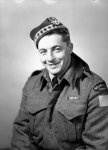
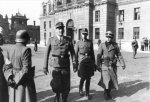
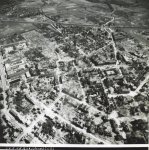
The German 444 and 485 Mobile Artillery Detachments, responsible for launching V-2 rockets, arrive at the Hague, the Netherlands. The units immediately begin to set up their equipment for a renewed rocket campaign against London.
In a one-on-one conversation between Adolf Hitler and Otto Skorzeny, Skorzeny tells of the kidnapping of Miklós Horthy, Jr. and the attack on Castle Hill in Budapest, Hungary on October 15. Later in the conversation, Hitler reveals to Skorzeny the plans for the Ardennes Offensive and asks him to plan a commando operation behind enemy lines in captured uniforms. When Skorzeny questions the legal concerns of wearing enemy uniforms, Hitler tells him that German intelligence informed him that the Americans had done the same in the Aachen, Germany area. Hitler orders Skorzeny to complete the planning by December 2.
Allied bombings continue as the US 8th Air Force attacks Hannover with 171 bombers, Brunswick with 148 bombers, Hamm with 353 bombers, Munster with 352 bombers, while the RAF Bomber Command sends 100 aircraft to attack Neuss during the day and 45 aircraft to attack Hamburg overnight.
In Italy, Canadian troops of the British 8th Army Attack around Monte Cavallo, battling across the Savio River, and capture Cervia and Pisignano, the US 5th Army attacks around Monte Salvaro, Monte Castellaro, Monte Spadura, and Monte Romano, while US 12th Air Force aircraft attack rail targets in northern Italy (in extremely limited operations due to poor weather conditions).
Pictured: Ernest Alvia ("Smokey") Smith, VC, CM, OBC, CD (3 May 1914 – 3 August 2005) - Canadian recipient of the Victoria Cross; Otto Skorzeny (left), Adrian von Fölkersam (middle), SS-Obersturmführer Walter Girg (right) in Budapest; Aerial shot of Muster after Allied bombing raid



That may have been true (although I doubt it; what American soldier would want to go into Aachen wearing a German uniform?), it would not make the German use of captured uniforms legal.October 22, 1944: ... Hitler reveals to Skorzeny the plans for the Ardennes Offensive and asks him to plan a commando operation behind enemy lines in captured uniforms. When Skorzeny questions the legal concerns of wearing enemy uniforms, Hitler tells him that German intelligence informed him that the Americans had done the same in the Aachen, Germany area.
I remember an old WW2 movie that featured a group of Germans wearing US uniforms at a cross roads. Can’t recall the title.That may have been true (although I doubt it; what American soldier would want to go into Aachen wearing a German uniform?), it would not make the German use of captured uniforms legal.
Sent from my iPhone using Tapatalk
Battle of the Bulge 1965 with Henry Fonda and Robert Shaw as Col. Hessler definitely featured Germans dressed as US Troops changing road signs, redirecting traffic and shooting American POW's.I remember an old WW2 movie that featured a group of Germans wearing US uniforms at a cross roads. Can’t recall the title.
Sent from my iPhone using Tapatalk
I do not recall Skorzeny's guys shooting American POWs, but Peiper's KG did.Battle of the Bulge 1965 with Henry Fonda and Robert Shaw as Col. Hessler definitely featured Germans dressed as US Troops changing road signs, redirecting traffic and shooting American POW's.
I remember near the end of that film the German tank crews "walking back to Germany," which I thought was bogus, but later I read that Peiper's KG did just that.
The Tiger II at La Gleize, Belgium is the last of Peiper's tanks.
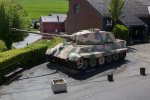
The rest were chopped up and carted away after the war.
Last edited:
I love the aerial pics in this thread and to be able to go to GE and recreate. Really wonder if the people living in a lot of the residences presently have any idea that bombs detonated there 75 years ago? To me, finding/seeing that would be surreal.
From time to time in Germany (and elsewhere in Europe) they find a dud and then the folks get reminded quite forcefully how much ordnance got dropped on those locations.I love the aerial pics in this thread and to be able to go to GE and recreate. Really wonder if the people living in a lot of the residences presently have any idea that bombs detonated there 75 years ago? To me, finding/seeing that would be surreal.
Oh yeah, for sure!From time to time in Germany (and elsewhere in Europe) they find a dud and then the folks get reminded quite forcefully how much ordnance got dropped on those locations.
October 23, 1944: The Canadian 1st Army continues the battle of the Scheldt, further reducing the Breskens pocket while, with the British 4th Armored Division, begins an assault to capture the railway dike to Beveland peninsula in Belgium. The British 2nd Army attacks toward Tilburg and 's Hertogenbosch. In US 12th Army Group sector, 9th Army, 1st Army, and 3rd Army regroup and prepare for new assaults, while to the south, US 7th Army attacks in the areas around Les Rouges Eaux, Fremifontaine, and Biffontaine in addition to ongoing attacks at Bruyeres and St. Die.
Allied Air Command continues pounding Germany, as US 15th Air Force attacks Plauen, Regensburg, and Rosenheim. RAF Bomber Command sends 1,055 aircraft to attack Essen overnight, where 1,163 buildings are destroyed and 820 are killed, sends 38 aircraft to attack Berlin overnight, 12 aircraft to attack Wiesbaden and Aschaffenburg overnight, and 112 aircraft to attack coastal battery at Flushing on Walcheren Island during the day.
In Italy, British 8th Army attacks around Monte Cavallo and along the Savio River. US 5th Army captures Monte Salvaro and continues attacking around Monte Termine, Vedriano, Monte Belmonte, Monte Spadura, Monte Cornazzano, Monte Ceco, Monte Giro, Monte Colombo, and Monte Casalino. US 12th Air Force aircraft attack rail lines, motor transport, and shipping around Savona, Turin, Padua, and Genoa, while US 15th Air Force attacks rail targets in northern Italy.
In an effort to ensure recognition of the Volkssturm as a legally recognized militia under international law, Berlin belatedly orders German troops to treat French Forces of the Interior as regular soldiers rather than illegal partisans. In Berlin, the official German news agency reports that vast numbers of volunteers are joining the Volkssturm militia, including men older than the specified age group and boys younger than specified.
Pictured: Churchill AVRE fascine carrier passing British infantrymen during the attack towards Hertogenbosch, the Netherlands, 23 Oct 1944; Map of Allied bombing runs from 23 Oct, 1944; Volkssturm march for the camera in Berlin - while these troops seemed to be well armed with new machine guns, legend has it that after the march they turned these weapons back to the soldiers from whom they were borrowed
Allied Air Command continues pounding Germany, as US 15th Air Force attacks Plauen, Regensburg, and Rosenheim. RAF Bomber Command sends 1,055 aircraft to attack Essen overnight, where 1,163 buildings are destroyed and 820 are killed, sends 38 aircraft to attack Berlin overnight, 12 aircraft to attack Wiesbaden and Aschaffenburg overnight, and 112 aircraft to attack coastal battery at Flushing on Walcheren Island during the day.
In Italy, British 8th Army attacks around Monte Cavallo and along the Savio River. US 5th Army captures Monte Salvaro and continues attacking around Monte Termine, Vedriano, Monte Belmonte, Monte Spadura, Monte Cornazzano, Monte Ceco, Monte Giro, Monte Colombo, and Monte Casalino. US 12th Air Force aircraft attack rail lines, motor transport, and shipping around Savona, Turin, Padua, and Genoa, while US 15th Air Force attacks rail targets in northern Italy.
In an effort to ensure recognition of the Volkssturm as a legally recognized militia under international law, Berlin belatedly orders German troops to treat French Forces of the Interior as regular soldiers rather than illegal partisans. In Berlin, the official German news agency reports that vast numbers of volunteers are joining the Volkssturm militia, including men older than the specified age group and boys younger than specified.
Pictured: Churchill AVRE fascine carrier passing British infantrymen during the attack towards Hertogenbosch, the Netherlands, 23 Oct 1944; Map of Allied bombing runs from 23 Oct, 1944; Volkssturm march for the camera in Berlin - while these troops seemed to be well armed with new machine guns, legend has it that after the march they turned these weapons back to the soldiers from whom they were borrowed
Attachments
-
54.5 KB Views: 0
-
104.1 KB Views: 0
-
88.2 KB Views: 0
- Status
- Not open for further replies.
Latest threads
-
-
-
SIAP there was an article that Joe K interviewed for assistant coach
- Started by mlingerfelt31
- Replies: 11
-
Final Home Midweek for Alabama Brings Samford to The Joe
- Started by Diamond Tide
- Replies: 0
-
-



